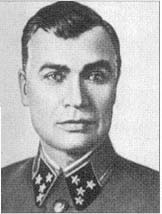Mikhail Petrovich Kirponos was born January 9, 1882, in Vertiyevka Chernigovskoi, a small village in the countryside in the Shumeikskogo area near Lokhvitsi (Poltava). He came from a family of farmers and during his youth years, he worked on the land of his father. During World War 1 he fought on the front against the Germans in the army of the Czar. At the end of the war, he joined the Bolsheviks and became a member of the Red Army. During the bloody, three-year civil war, Kirponos soon rose in the ranks of the Red Army. At the time, there were no ranks in the army but he rose from battalion commander to regimental commander. After the Red Army had won the war, Kirponos became Kommissar in various divisions, occupying himself mainly with staff work. From 1934 to 1939 he stood at the head of the military academy of Kazan.
During the Winter War against Finnland Kirponos commanded one of the few successful Soviet divisions, the 70th Fusileers Division. Joseph Stalin was impressed by Kirponos` achievements and as a result of the cleansing Kirponos was put in charge of a Fusileer Corps in April 1940. Three months later, Kirponos was given command of the Military District Leningrad. Due to the increasing tension between Germany and the Soviet Union, Kirponos was given command of the Special Military District Kiev in May 1941. When the Germans invaded the Soviet Union on June 22, 1941, this district was renamed the Southwestern Front. Two days later, a massive Soviet counter-attack was launched under command of Kirponos, making life for 1. Panzergruppe under Ewald von Kleist very difficult. Dubno was the scene of massive tank battles. Due to the poor condition of the mechainzed units however, this attack failed miserably and Kirponos withdrew his forces in the direction of Kiev, inflicting heavy casualties in a brilliant way to German Heeresgruppe Süd under Feldmarschall Gerd von Rundstedt.
The Southwestern Front and the Southern Front were the only forces which were able to put up anything like resistance against the Germans. Owing to the direct orders by Joseph Stalin, Kirponos was not given permission to retreat, resulting in a massive encirclement near Uman. Stalin had dispatched Marshal Semyon M. Budjonny and General Georgy K. Zhukov to the Ukraine in order to support the actions in the southwestern sector. Soviet resistance remained fierce, causing Hitler to decide in August that 2. Panzergruppe under Heinz Guderian had to turn to the south to eliminate the Soviet forces in the Ukraine. Kirponos established special units to force Soviet soldiers, under threat of execution, to continue fighting thus preventing a chaos from occuring like what happened elsewhere on the Eastern front. Nonetheless, a massive force was encircled near Kiev. Stalin did not allow Kirponos to withdraw his troops to the right bank of the Dniepr and as a result, 600,000 men were surrounded. Kirponos made a few desperate attempts to break out of the encirclement and in the course of his last attempt, September 20, 1941, he was mortally injured by shrapnell. Other sources claim Kirponos took his own life.
Kirponos was posthumously awarded the Order of the Patriotic War.
Definitielijst
- Division
- Military unit, usually consisting of one upto four regiments and usually making up a corps. In theory a division consists of 10,000 to 20,000 men.
- Heeresgruppe
- The largest German ground formation and was directly subordinate to the OKH. Mainly consisting of a number of “Armeen” with few directly subordinate other units. A Heeresgruppe operated in a large area and could number several 100,000 men.
- Marshal
- Highest military rank, Army commander.
- Red Army
- Army of the Soviet Union.
- resistance
- Resistance against the enemy. Often also with armed resources.
- Soviet Union
- Soviet Russia, alternative name for the USSR.
Information
- Article by:
- Tom Notten
- Translated by:
- Arnold Palthe
- Published on:
- 17-06-2020
- Last edit on:
- 12-10-2023
- Feedback?
- Send it!
Sources
- Zalleski K.A., Stalin's Empire: biographical encyclopedia, Moskou, 2000
- Hronos.km.ru





